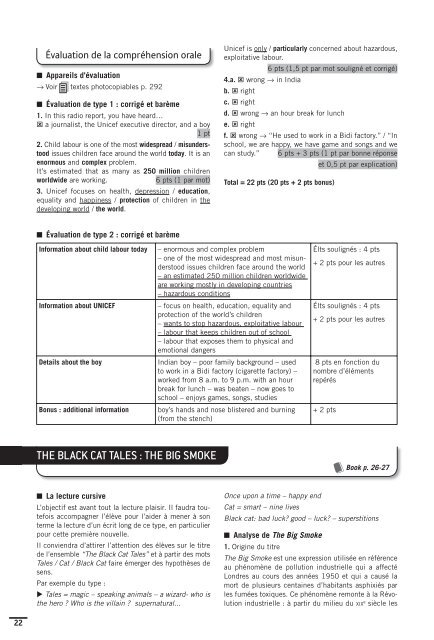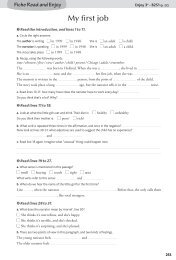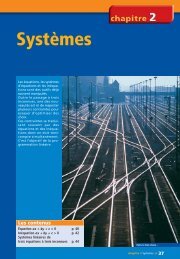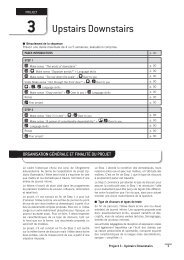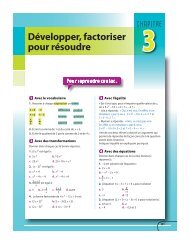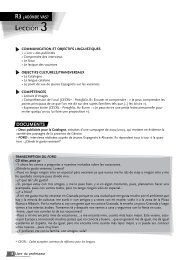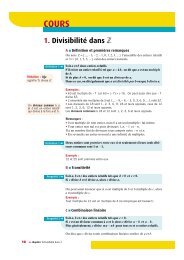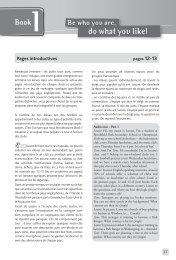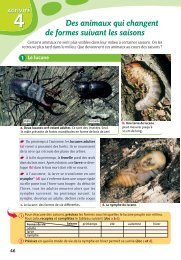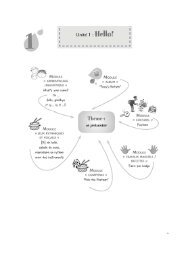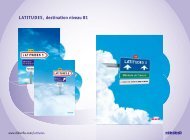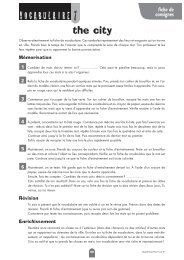Children at work - Didier
Children at work - Didier
Children at work - Didier
Create successful ePaper yourself
Turn your PDF publications into a flip-book with our unique Google optimized e-Paper software.
n<br />
Évalu<strong>at</strong>ion de la compréhension orale<br />
Appareils d'évalu<strong>at</strong>ion<br />
Æ Voir textes photocopiables p. 292<br />
n Évalu<strong>at</strong>ion de type 1 : corrigé et barème<br />
1. In this radio report, you have heard…<br />
˝ a journalist, the Unicef executive director, and a boy<br />
1 pt<br />
2. Child labour is one of the most widespread / misunderstood<br />
issues children face around the world today. It is an<br />
enormous and complex problem.<br />
It’s estim<strong>at</strong>ed th<strong>at</strong> as many as 250 million children<br />
worldwide are <strong>work</strong>ing.<br />
6 pts (1 par mot)<br />
3. Unicef focuses on health, depression / educ<strong>at</strong>ion,<br />
equality and happiness / protection of children in the<br />
developing world / the world.<br />
Unicef is only / particularly concerned about hazardous,<br />
exploit<strong>at</strong>ive labour.<br />
6 pts (1,5 pt par mot souligné et corrigé)<br />
4.a. ˝ wrong Æ in India<br />
b. ˝ right<br />
c. ˝ right<br />
d. ˝ wrong Æ an hour break for lunch<br />
e. ˝ right<br />
f. ˝ wrong Æ “He used to <strong>work</strong> in a Bidi factory.” / “In<br />
school, we are happy, we have game and songs and we<br />
can study.” 6 pts + 3 pts (1 pt par bonne réponse<br />
et 0,5 pt par explic<strong>at</strong>ion)<br />
Total = 22 pts (20 pts + 2 pts bonus)<br />
n<br />
Évalu<strong>at</strong>ion de type 2 : corrigé et barème<br />
Inform<strong>at</strong>ion about child labour today<br />
Inform<strong>at</strong>ion about UNICEF<br />
Details about the boy<br />
Bonus : additional inform<strong>at</strong>ion<br />
– enormous and complex problem<br />
– one of the most widespread and most misunderstood<br />
issues children face around the world<br />
– an estim<strong>at</strong>ed 250 million children worldwide<br />
are <strong>work</strong>ing mostly in developing countries<br />
– hazardous conditions<br />
– focus on health, educ<strong>at</strong>ion, equality and<br />
protection of the world’s children<br />
– wants to stop hazardous, exploit<strong>at</strong>ive labour<br />
– labour th<strong>at</strong> keeps children out of school<br />
– labour th<strong>at</strong> exposes them to physical and<br />
emotional dangers<br />
Indian boy – poor family background – used<br />
to <strong>work</strong> in a Bidi factory (cigarette factory) –<br />
<strong>work</strong>ed from 8 a.m. to 9 p.m. with an hour<br />
break for lunch – was be<strong>at</strong>en – now goes to<br />
school – enjoys games, songs, studies<br />
boy’s hands and nose blistered and burning<br />
(from the stench)<br />
Élts soulignés : 4 pts<br />
+ 2 pts pour les autres<br />
Élts soulignés : 4 pts<br />
+ 2 pts pour les autres<br />
8 pts en fonction du<br />
nombre d’éléments<br />
repérés<br />
+ 2 pts<br />
THE BLACK CAT TALES : THE BIG SMOKE<br />
Book p. 26-27<br />
n<br />
La lecture cursive<br />
L’objectif est avant tout la lecture plaisir. Il faudra toutefois<br />
accompagner l’élève pour l’aider à mener à son<br />
terme la lecture d’un écrit long de ce type, en particulier<br />
pour cette première nouvelle.<br />
Il conviendra d’<strong>at</strong>tirer l’<strong>at</strong>tention des élèves sur le titre<br />
de l’ensemble “The Black C<strong>at</strong> Tales” et à partir des mots<br />
Tales / C<strong>at</strong> / Black C<strong>at</strong> faire émerger des hypothèses de<br />
sens.<br />
Par exemple du type :<br />
u Tales = magic – speaking animals – a wizard- who is<br />
the hero ? Who is the villain ? supern<strong>at</strong>ural...<br />
Once upon a time – happy end<br />
C<strong>at</strong> = smart – nine lives<br />
Black c<strong>at</strong>: bad luck? good – luck? – superstitions<br />
n Analyse de The Big Smoke<br />
1. Origine du titre<br />
The Big Smoke est une expression utilisée en référence<br />
au phénomène de pollution industrielle qui a affecté<br />
Londres au cours des années 1950 et qui a causé la<br />
mort de plusieurs centaines d’habitants asphixiés par<br />
les fumées toxiques. Ce phénomène remonte à la Révolution<br />
industrielle : à partir du milieu du XIX e siècle les<br />
22


